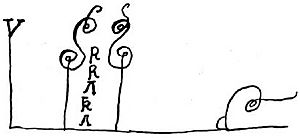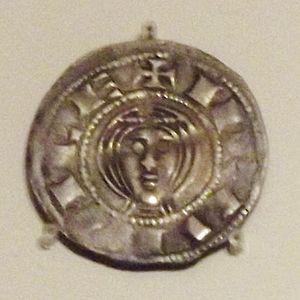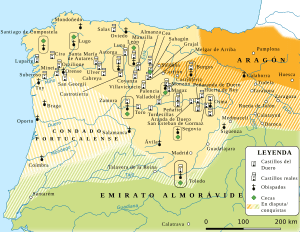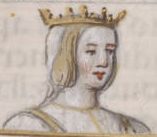Urraca of León facts for kids
Quick facts for kids Urraca |
|
|---|---|
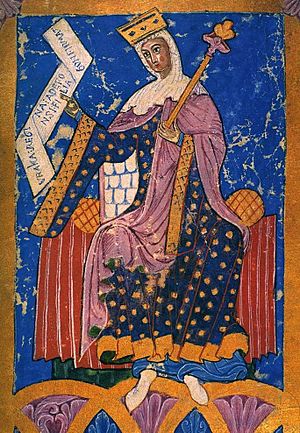
13-century miniature of Queen Urraca presiding at Court from Tumbo A codex
Santiago de Compostela Cathedral. |
|
| Queen of León, Castile, and Galicia | |
| Reign | 1109 – 1126 |
| Predecessor | Alfonso VI |
| Successor | Alfonso VII |
| Queen consort of Aragon and Navarre | |
| Tenure | 1109 – 1114 |
| Born | April 1079 Burgos |
| Died | 8 March 1126 (aged 46) Saldaña on the Río Carrión in Castilla |
| Burial | Basilica of San Isidoro |
| Spouse | Raymond of Burgundy Alfonso the Battler |
| Issue | Sancha Raimúndez Alfonso VII of León and Castile Fernando Pérez Furtado Elvira Pérez de Lara |
| House | Jiménez |
| Father | Alfonso VI of León and Castile |
| Mother | Constance of Burgundy |
| Religion | Roman Catholicism |
Urraca (around 1080 – 8 March 1126), also known as the Bold, was a powerful queen. She ruled the kingdoms of León, Castile, and Galicia from 1109 until her death. She even called herself the Empress of All Spain and Empress of All Galicia. This made her one of the most important rulers of her time.
Contents
Early Life of Queen Urraca
Urraca was born to King Alfonso VI of León and Castile and Constance of Burgundy. Her mother, Constance, was related to the French royal family. Urraca was likely born in Sahagún or León around 1080 or 1081. She was the only child of her parents. We don't know much about her childhood. She mentioned two clergymen, Presbyter Pedro and Domingo Falcóniz, as her teachers. Her aunt, Elvira, also helped care for Urraca's daughter, Sancha.
First Marriage and Becoming a Widow
Urraca married Raymond of Burgundy. This marriage was part of her father King Alfonso VI's plan. He wanted to make strong alliances after a big defeat by the Muslim Almoravids in 1086. Urraca and Raymond were first mentioned as husband and wife around 1093. They became rulers of Galicia.
Raymond was in charge of Galicia, but King Alfonso VI still had control. A talented clergyman, Diego Gelmírez, helped Raymond and Urraca. They also helped manage other areas like Ávila and Segovia.
In 1093, Urraca's mother died. Her father then had a son, Sancho Alfónsez, with another woman. This meant Urraca was no longer her father's only heir. Her power became even weaker when her father gave the "Land of Portugal" to her half-sister, Theresa, and her husband.
As a woman, Urraca was under her husband's care. Raymond was usually listed first in documents. But in some documents from 1095 and 1105, Urraca was called "Queen Urraca." This might show she was not happy with her lower position.
Her half-brother Sancho was seen as the next king from 1103. Raymond and his brother-in-law Henry of Portugal made a deal. They planned to divide their father-in-law's lands.
Raymond became very ill and died in September 1107. Urraca then took full control of Galicia. She called herself "empress of whole Galicia." The nobles and church leaders in Galicia saw Urraca's young son, Alfonso Raimúndez, as Raymond's rightful heir. King Alfonso VI also agreed that his grandson should rule Galicia if Urraca remarried.
Around this time, Urraca started a relationship with a Castilian noble, Gómez González. Then, her half-brother Sancho died in battle in May 1108. This made Urraca her father's only heir. Her new position was confirmed by many nobles and counts. Her father died shortly after, in July 1108.
Urraca's Reign
Her Second Marriage
Urraca became the first reigning queen in European history. Her first royal document called her "queen of whole Spain." Many important nobles and bishops supported her.
Some sources say that nobles wanted Urraca to marry Alfonso I, the King of Aragon and Navarre. They thought a woman could not rule and defend the kingdom alone. They reportedly forced Urraca to marry Alfonso I, whom they called "the bloodthirsty and cruel Aragonese tyrant." However, other sources say her father, King Alfonso VI, started the marriage talks. He wanted to stop Urraca from marrying her lover, Gómez González. Both reasons might be true.
Alfonso I married Urraca in October or November 1109. Urraca gave her lands to her new husband. She said he must treat her "like a good husband his good wife." She also made sure her son from her first marriage would inherit León if she and Alfonso had no children.
The nobles in Galicia wanted more independence. They used Urraca's son, Alfonso Raimúndez, as a reason to rebel. They said Urraca lost her right to rule Galicia when she remarried. They even made Alfonso Raimúndez king.
Alfonso I and Urraca invaded Galicia. They captured a castle, but the Aragonese troops were very cruel. This made the Leonese nobles angry. The relationship between Alfonso I and the church leaders also became difficult. Some bishops were jailed, and others had to flee.
The marriage was not happy. Alfonso I did not like Urraca's son. Urraca disliked her husband's beliefs. He often shamed and even hit her in public. Urraca soon wanted to be free of her husband's control. She started calling herself "queen of whole Spain and daughter of Emperor Alfonso" in documents.
Urraca separated from Alfonso. The last document showing them together was from May 1112.
The marriage caused many problems. Rebellions started in Galicia. Her half-sister Theresa and her husband also caused trouble. They worried that Urraca's new marriage would harm her son's rights. Urraca and Alfonso I signed a pact. They agreed that their future children would inherit both kingdoms. If they had no children, the surviving spouse would rule both.
The Galician rebels were divided. One group wanted Urraca's son to be her successor. Another wanted Galicia to be fully independent. A third group at court, led by Count Gómez González, feared losing power. Alfonso I gave important jobs to Aragonese and Navarrese nobles.
The Count of Traba started the first attack in Galicia. He demanded Alfonso Raimúndez's rights. Alfonso I marched his army into Galicia and restored order in 1110. But this was just the start of many conflicts. Urraca and Alfonso I had very different personalities. They disliked each other, which led to a civil war for years. Urraca did not share power with her husband.
By May 1110, she separated from Alfonso. She disagreed with how he handled rebels. He executed a rebel who had surrendered to her, and Urraca wanted to be merciful. Also, many people in the kingdom did not like her marriage. Her son became a symbol for those who opposed the marriage.
The conflict between Urraca and Alfonso grew into open war. Alfonso of Aragon and Henry of Portugal formed an alliance. In 1111, Urraca's main supporter, Gómez González, was killed in battle. Another count, Pedro González de Lara, took over the fight.
By late 1112, a truce was made, and their marriage was ended. Urraca got back Asturias, León, and Galicia. But Alfonso still held parts of Castile. Her half-sister Theresa and her husband took over Zamora and Extremadura. Urraca spent much of her time trying to get these lands back and expand into Muslim territories.
While fighting these battles, Urraca also had to deal with her sister's plans. Theresa wanted to replace Urraca with her son. This ended with a compromise. Theresa was given a large area in León. In return, she agreed to be Urraca's vassal.
Historians say Urraca's success was her ability to protect her father's kingdom. She passed it on to her son completely. Her father's actions, like legitimizing her brother and forcing her marriage, created many challenges for her. But Urraca used her unique position as a female ruler to her advantage in politics.
Queen Urraca's Character
The Historia Compostelana describes Urraca as smart, humble, and sensible. She was clearly in control of events during her reign.
Death and Legacy
As queen, Urraca faced many challenges. She found practical solutions. Her actions helped prepare the kingdom for her son, Alfonso VII. Despite some opposition, Alfonso VII became king of a whole and peaceful kingdom after Urraca's death in 1126. Her reign also set an important example for future queens.
Queen Urraca's Family
Urraca's first child with Raymond, Sancha, was born before November 1095. She was named after Urraca's grandmother, Sancha of León. Her second child, Alfonso, was born around 1105. He was named after Urraca's father.
Urraca also had two children with her lover, Pedro González de Lara. They were Fernando Pérez Hurtado (born around 1114) and Elvira Pérez de Lara (born around 1112). Elvira later married twice.
See also
 In Spanish: Urraca I de León para niños
In Spanish: Urraca I de León para niños


